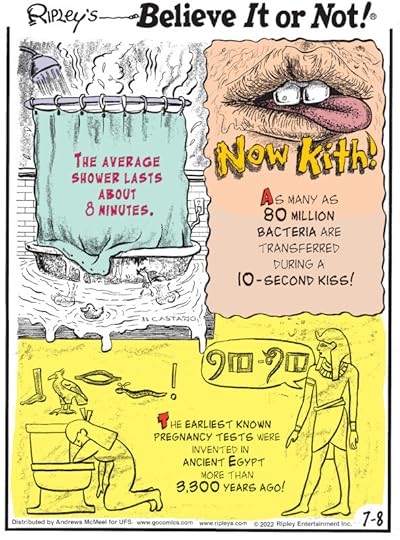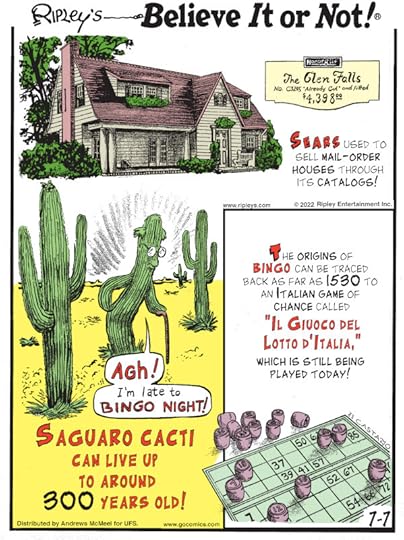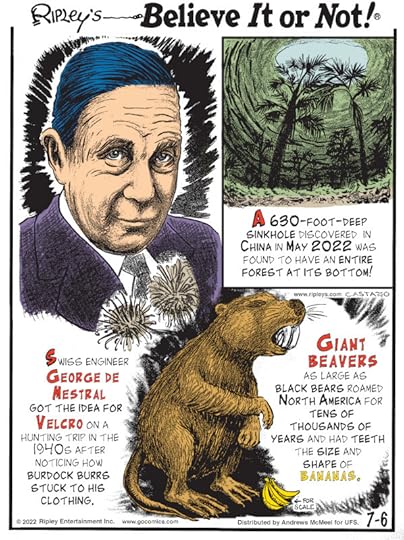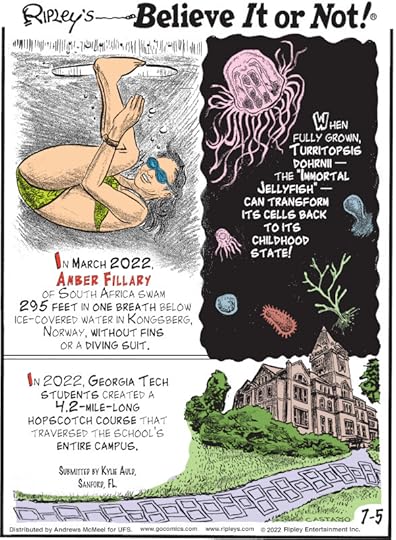Ripley Entertainment Inc.'s Blog, page 78
July 9, 2022
CARTOON 07-09-2022
July 8, 2022
The Quiz Show Rigging Scandal
Featured in Ripley's Believe It or Not!

It wasn’t long after the invention of the television that game show and quizzing programs began making their big on-screen debut. While we all enjoy a cozy night in with our favorite game show, the history behind some of them are quite scandalous!
Starting with The $64,000 QuestionIn a train of game shows to come, the first was CBS’s The $64,000 Question. A national phenomenon, the show hit 47 million viewers in just ten weeks! It pitted the common man or woman against an expert in a series of obscure questions from their own field. The payout for victory was no joke. At the time, no surprise here, winning contestants, won a sum of $64,000. By today’s standard, that’s equivalent to about $655,000!

Joyce Brothers, American psychologist, television personality, advice columnist, and writer. Via Wikimedia Commons.
One fan-favorite contestant, psychologist, Joyce Brothers emerged victorious on two separate accounts, beating a panel of boxers as the expert in their own sport! Joyce should have been the underdog in this battle of boxing wits, but she was no fool when it came to studying up on the subject. She read 20 volumes of encyclopedias on boxing! Her knowledge and commitment to being the winning expert made her very popular among viewers. Naturally, audiences gushed in awe of Joyce’s success—making for good ratings and a familiar face.
However, the producers quickly tired of her spotlight moments and winning streak. They deemed it unfair that Joyce wasn’t allowing for others to win the show and called her fact recollection “superficial knowledge” of boxing. In an attempt to force Joyce into losing, the producers crafted near-impossible questions that would truly put Joyce’s knowledge to the test. She won anyway, but the show was certainly on the road to a dishonest and fixed outcome.
Twenty-One Points for Herbert StempelAnd then, there was the crème de la crème of game show scandals. The icing on the cake, if you will, to ignite the beginning of the end when it came to quiz shows. Twenty-One was a simple question and answer game, with two competitors battling against one another to reach a 21-point total from correct responses. Just two telecasts into the NBC quiz show, a man named Herbert Stempel—soon to be known as the quiz rigging scandal whistleblower–applied to be a contestant.
Herbert was an honest, brilliant man with genuine intentions. At the time of his application, he was 29-year-old college student, graduate from Bronx High School of Science, and had an above average IQ score. Knowing his worth and abilities for a contest of this nature, he wrote to producers with an interest in competing on the show and a few days later received his invitation to come on board.
After passing the entry exam with flying colors and the highest score the show had seen to date, Twenty-One producers made the decision to bring Herbert on… as the “villain.” It was believed that Herbert was the perfect candidate to manipulate viewers, causing them to root for the underdog, and watching the show simply in hopes that Herbert would lose.
The CatchDaniel Enright, one of the show’s producers, visited Herbert at his home and made him a deal he couldn’t refuse: $24,000 to follow a script, portray a character, and demonstrate a dorky persona once in front of the camera. For five weeks, Daniel and Herbert rehearsed questions, answers, show order, deliberate mistakes, stage directions, and even gestures down to eyebrow raises and verbal pauses!
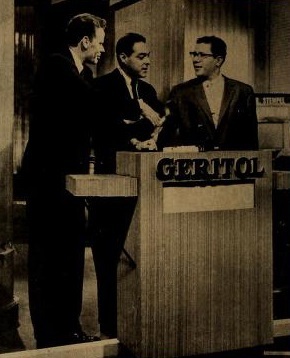
Herbert Stempel (Right) with Charles Van Doren and Jack Barry on Twenty-One, 1957. Via Wikimedia Commons.
Herbert’s deal landed him $50,000 as his final opponent, Charles Van Doren, entered the scene. Once they made it to a third show ending in a tie, Herbert caught on that Charles was likely in on the action, as well. His good ol’ buddy Daniel was pulling the rug out from under him saying that the show had reached a plateau, and it was time for a change—entering Charles and bidding Herbert adieu.
On the morning of his final show, the hype surrounding the battle of a lifetime was at an all-time high. Would Herbert leave with the greatest prize in Twenty-One history? Unfortunately, he inevitably would not. The final question was asked and, though he knew the correct answer, Herbert blew the contest, as scripted.
Following the show, Herbert overheard someone backstage say, “Now we have a clean-cut intellectual as champion instead of a freak with a sponge memory.” Even at his peak, Herbert never had a moment of the true fame that Charles was gaining in just a few episodes.
Justice for Herbert? / Herbert’s RevengePrior to the start of this finale showdown, Herbert contacted a reporter from the New York Post to let him know that Twenty-One was rigged, but to no avail, his claim was brushed to the side. It wasn’t until years later, after many additional broken promises from his pal Daniel, including more money post-show and a full-time gig with the network, that Herbert went back to the press. This time, he talked to New York “Journal-American,” who investigated the charges but could find no further witnesses. Herbert’s story, again, fell on deaf ears.
It wasn’t until other popular shows at the time started to fall under closer review that the papers printed Herbert’s story. Congress investigated the claims and physical evidence of both Herbert Stempel and another Twenty-One contestant, James Snodgrass–who had also been given answers on the show–and concluded that the show was in fact, rigged.
Though it’s a bummer to hear the series of events ultimately leading to the demise of quizzing shows–at least for a while–we have them to thank for the creation of one of our favorites today: Jeopardy! Shoutout to producer, Merv Griffin, for reviving a fair, honest, and knowledge-based show that allows contestants to win some, lose some, and have a great time!
Source: The Quiz Show Rigging Scandal
CARTOON 07-08-2022
July 7, 2022
The 19th-Century Entrepreneur Who Pioneered Modern Ice Cream
Featured in Ripley's Believe It or Not!

Without the talented mind of girl boss, Agnes B. Marshall, ice cream would simply not be what it is today. Now, we have ice cream shops where people line the streets on a hot summer night just to get a lick of their favorite flavor. From soft serve to homemade to nitrogen-based, ice cream is readily available to the masses and takes on many different forms in the modern day era.
The Inside ScoopBack in the Victorian age when Marshall was a pioneer in the culinary world, ice cream access was a bit more exclusive. The upper class were the only folks who had the resources to store this creamy delicacy. During this time, the wealthier families owned ice houses and that was the only way to ensure it stayed a mere frozen temperature. Today, with the invention of freezers, it’s a beloved dessert for all to enjoy.
Marshall, also known as Queen of Ices, was introduced to cooking at a very young age and learned from famous European chefs. Not much was known about her youth, but we do know she grew to conquer the category of frozen desserts.

Agnes B Marshall. Via Wikimedia Commons.
She eventually purchased land on Mortimer Street in London, England and opened Marshall’s School of Cookery. Marshall was a marketer before marketing was even a thing. She put ads in newspapers to promote that she was offering classes and people showed up. About a year later, she was teaching up to six classes per week!
Savor the FlavorMarshall went above and beyond the traditional vanilla, chocolate, and strawberry. She invented unique flavors that were mixed with spices and vegetables. Now that’s one way to get your kids to eat their veggies!
One of her most interesting creations consisted of cayenne, jelly, goose liver and frozen eggs, and to top it all off, was molded into the shape of a duck! She also used cucumber, tomatoes, peas and lobster in her slew of savory ice cream recipes.
Marshall published a cookbook called The Book of Ices and continued with her marketing magic. She set up live shows where she traveled around the country and tested new recipes in front of large crowds. Marshall referred to this tour as “The Pretty Luncheon”.
She knew there was opportunity to leverage this luxe dessert with the middle class. Although they may not have had places to necessarily store the ice, there was no reason that this group of ice cream aficionados shouldn’t get to experience this swanky sweet. Insert: in-home ice cream machines.
How cold? Ice cold!
Marshall’s patent freezer complete view. Via Wikimedia Commons.
In the early 19th century, the first ice cream machines to pop up consisted of a metal container inside a wooden tub full of ice and salt. The ice cream mixture was then transferred into the machine’s metal container and churned. This created that smooth, lavish creaminess we love about our ice cream. Marshall took this to the next level. She used her expertise to develop and patent one of the earliest home ice cream makers, which was shallower and broader than previous models. Believe it or not!, this device could make ice cream and subsequently freeze it in just five minutes flat compared to the 40 minutes it usually took prior to this technology.
During her peak of innovation, Marshall wrote a few more cookbooks and a magazine called The Table. She also dabbled with the idea of using “liquid Oxygen” to freeze ice cream at home. It was formed by adding some liquid oxygen drops and stirring with the other ingredients. Familiar to today’s TikTok and Instagram users alike, this concept has turned into “Nitrogen ice cream” and is trendy with today’s frequent fad followers.
Cone-gratulationsMarshall was also partially responsible for edible ice cream cones. One of her recipes used eggs, flower, sugar, and almonds, which made for a wafer-like mix called a “cornet”. Marshall encouraged those around her to eat these cornets with cream. The cornets looked a lot different than modern-day cones and were meant to be laid across a plate rather than handheld.
According to The Hustle, Marshall is honored at a St. Louis-based nitro ice cream shop called “Ices Plain & Fancy” as a tribute to her cookbook Fancy Ices. Her portrait can be found on the wall and she even has her very own flavor – “Mrs. Marshall’s Old Fashioned Ice Cream”! This is the spot to be if you want to celebrate the history of your favorite frozen treat.
By Sam McCormack, contributor for Ripleys.com
EXPLORE THE ODD IN PERSON! Discover hundreds of strange and unusual artifacts and get hands-on with unbelievable interactives when you visit a Ripley’s Odditorium!Source: The 19th-Century Entrepreneur Who Pioneered Modern Ice Cream
CARTOON 07-07-2022
July 6, 2022
How Did People Book Flights Before The Internet?
Featured in Ripley's Believe It or Not!

In today’s day and age, you can secure a seat on a flight simply with the click of a few buttons. In a matter of minutes, your confirmation will come through on your mobile device and you’ll be ready to jet off to your destination.
But a little less than a century ago, booking your solo adventure or family vacation wasn’t that easy. Think about the steps you would take to book an upcoming trip. Now think about doing it… without the internet.
Sounds tough, right? No ability to search for the cheapest fares. No way to choose a specific seat for all those window dwellers or aisle lovers. No screenshots or apps to store your precious boarding pass and flight confirmation. And absolutely no chance you’ll have a stress-free time canceling or rescheduling.
Air Travel is Sky HighAfter World War II, traveling by plane became very desirable amongst Americans. Major airlines created their own reservations offices where representatives took calls from travel agents and operators. Travel agents did make a commission from flight reservations they coordinated, but they couldn’t physically complete the booking themselves, nor could the traveler. A third party was always involved, and each reservation took about 90 minutes to complete. This caused for lots of back and forth on the phone resulting in inevitable ticketing errors.
During the 1930s — before we had Google, Bing, or even Ask Jeeves — there was a master board, which used light bulbs to display availability on scheduled flights. Sometimes flight info was stored in a separate spot if there wasn’t enough room left on the availability board. The customers’ names and info were written manually on a card, which was then brought to the ticketing office. Here, the operators would manually write out each ticket by hand.
This process became a bit more complicated though once air travel started catching wind (literally and figuratively). As flying increased in popularity, there was greater demand to keep up with and not enough physical space or hands to do so.
View this post on Instagram
A post shared by SFO Museum (@sfomuseum)
In 1946, American Airlines, a leader in the aviator industry, pioneered a state-of-the-art computerized booking system as a temporary solution. It was called the “Reservisor.” It was first installed in American Airlines’ Boston reservation center. This system wasn’t flawless and still required manual work by operators, but it helped to speed up the booking process in the meantime.
How Did It Work?The Reservisor connected to a room of electric energy, full of various switches and cables, that worked together to record updated seating availability digitally. This new and advanced labor-light computer terminal was able to process 200 more passengers every day. There were still some major issues with this method, as expected in the startup phase. About 1 in 12 reservations were still wrong, which we’re sure resulted in several angry flyers and frustrated operators.
Despite the technological advances being made, the communication factor was still missing. Plus, it only helped to manage inventory control. Names and traveler information was still housed on index cards, which were transported from desk to desk throughout the reservation office.
Time to upgrade!Soon thereafter, the Reservisor became the Magnetronic Reservisor. Using a magnetic disc, a reservations officer could insert it into the desktop unit along with the flight date and number of seats requested. Seat availability for that specific flight would pop up within seconds. If a passenger went ahead to purchase the airline tickets, then the reservations officer could update the seat inventory on the disc with the flip of a switch.
PAPER: The Magnetronic Reservisor
How airlines did electronic ticket reservations in the 1950shttps://t.co/flAF9VaolR pic.twitter.com/NjM0xSNm0B
— Fermat’s Library (@fermatslibrary) September 26, 2017
This new and advanced system was put to the test in New York’s LaGuardia Airport in 1952. With this updated technology, travel agents, or even travelers in some cases, could book remotely from the New York area. If they had this coveted metal disc, they were able to slide it into their desk set and the request was communicated back to LaGuardia.
The Magnetronic Reservisor had the “brain power” to remember information for 1,000 flight legs per day over a 12-day span of storage or 10,000 units of flight memory. This was also equivalent to 100 seats of inventory per flight.
SABRE Disrupts the IndustryBuilt by IBM for American Airlines with inspiration and expertise from the US Air Force’s ground-control environment, SAGE, the two powerhouses were able to collaborate on SABRE. SABRE stood for Semi-Automated Business Research Environment and was the first computerized booking system. This innovation in the world of air travel took about seven years to complete and was finalized in 1964. SABRE was capable of booking 7,000 reservations with little to no error.
This was also one of the first technologies to store passenger information which helped bookings go a lot more smoothly. Although American put approximately 40 million dollars into this system, SABRE helped the airline company soar to new heights. They were quickly becoming a leader and disrupter in the air travel market.
The Future of FlyingAir travel became a way of life and airlines were faced with a huge influx of passengers craving new destinations. Insert internet ticketing. The internet has opened so many possibilities in the world of air travel that getting from one place to the next has never been easier. Now we invite you to go enjoy a latté in your terminal and thank the creators of the world wide web.
By Sam McCormack, contributor for Ripleys.com
EXPLORE THE ODD IN PERSON! Discover hundreds of strange and unusual artifacts and get hands-on with unbelievable interactives when you visit a Ripley’s Odditorium!CARTOON 07-06-2022
July 5, 2022
Shark-Liver-Eating Serial Killer Whales Lock Down South Africa’s Coast
Featured in Ripley's Believe It or Not!

Perhaps the most iconic line from 1991’s “The Silence of the Lambs” comes from Dr. Hannibal Lecter (played by Anthony Hopkins): “I ate his liver with some fava beans and a nice Chianti.” He delivers the line calmly and creepily, but most people don’t realize there’s a joke in his choice of sides, per the Independent. You see, the doctor’s character likely underwent treatment with monoamine oxidase inhibitors (MAOIs), making wine, beans, and liver serious no-nos.
Apparently, liver’s too mouthwatering to pass up for some creatures in the animal kingdom, though. Take, for example, the tale of Starboard and Port, two killer whales with a penchant for systematically hunting down great white sharks to nibble on their livers.
Here’s the gruesome story of the apex predators who’ve put the “killer” back in killer whales through their oceanic reign of terror.
Bye-Bye, Great WhitesGreat white sharks rank near the top of the food chain, and with good reason. According to Oceana, they grow upwards of 20 feet long and tip the scales at 6,600 pounds. Their jaws contain rows of razor-sharp, serrated teeth capable of growing up to 6.6 inches tall. As opportunistic predators, they have a reputation for indiscriminate (sometimes devastating) bites that can leave humans in a world of hurt.

But despite decades of hysteria about shark attacks, these predatory fish prefer sea lions, seals, dolphins, seabirds, and turtles. What’s more, like “Cannibal Hannibal,” they’re okay with eating other sharks. In other words, great whites hold their own in the ocean food chain. Or so we thought until Starboard and Port, two male orcas, entered the picture. The pair have been slaughtering great whites since 2017 off the Gansbaai coast in South Africa, leaving plenty of grisly evidence behind.
Murder Most OceanicScientists have discovered the remains of at least eight sharks the orca duo has torn to shreds in recent years, bearing signs of a horrific feast. All but one shark washed ashore with its liver missing. And some victims have had their hearts devoured, too. The ferocity of killer whales is celebrated in their name and confirmed through sightings of them devouring everything from sea lions to blue whales. Nevertheless, it’s hard to find another time in recorded history where two orcas have so drastically impacted local ecosystems. Clearly, Starboard and Port have taken it next level, wreaking havoc on shark populations, as the reports.
Since 2017, researchers say shark sightings have nose-dived. Not only because of the killings but also the tendency of great whites to now avoid Starboard and Port’s hunting grounds. And can you blame them? Scientists know this because of tagging data and long-term sightings. Before the killing spree began, these areas of the Gansbaai coast, 75 miles from Cape Town, swarmed with great whites. But the murderous orcas have locked down the coast.
The Liver-Loving Orcas of South Africa
The legendary shark snacking Killer #whales „Port“ & „Starboard“ are back in False Bay, #CapeTown. Named after their collapsed dorsal fins, they were spotted on the eastern shores of the bay, off Kogel Bay, yesterday afternoon. Pic from a previous visit… #orca pic.twitter.com/we2bhzGJEc
— Seafari (@SeafariApp) January 17, 2022
Because of the large number of great white sharks that once swam the waters near Gansbaai, an active shark observing industry had developed, drawing tourists from all over the world. But the new main attractions are the orcas themselves. Starboard and Port prove easily recognizable because of their battle scars, betraying countless tussles with toothy prey. Each whale’s dorsal fin has collapsed to one side, inspiring the names Port and Starboard. Of course, where the duo goes, shark bodies wash up on shore … heartless and liverless.
Why are Starboard and Port on such a targeted killing spree? Some scientists hypothesize it’s in their DNA. In recent years a new subspecies of orca has been discovered off the coast of South Africa, distinguished by its flat teeth and impeccable shark hunting skills. Some believe the two male orcas in question belong to this subgroup. But before the ocean-sized mystery can be solved, scientists stress more shark and whale observation is needed.
By Engrid Barnett, contributor for Ripleys.com
EXPLORE THE ODD IN PERSON! Discover hundreds of strange and unusual artifacts and get hands-on with unbelievable interactives when you visit a Ripley’s Odditorium!Source: Shark-Liver-Eating Serial Killer Whales Lock Down South Africa’s Coast
CARTOON 07-05-2022
July 4, 2022
CARTOON 07-04-2022
Ripley Entertainment Inc.'s Blog
- Ripley Entertainment Inc.'s profile
- 52 followers



